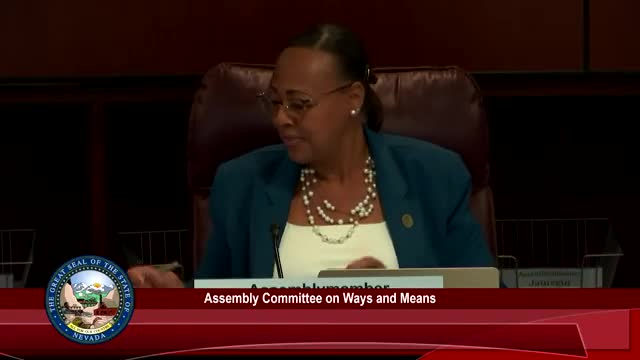Nevada committee hears bill to give education support professionals full PERS service credit
March 29, 2025 | 2025 Legislature NV, Nevada
This article was created by AI summarizing key points discussed. AI makes mistakes, so for full details and context, please refer to the video of the full meeting. Please report any errors so we can fix them. Report an error »

Assemblymember Max Carter introduced Assembly Bill 232 on the evening docket of the Assembly Ways and Means Committee to restore retirement-credit parity for education support professionals (ESPs), including paraprofessionals, bus drivers, food service staff and other classified school employees.
AB 232 would allow classified school employees who work at least 900 hours across at least eight calendar months in a school year to receive one full year of PERS service credit, rather than the partial credit many currently receive. The sponsor said the change was developed with the Nevada Public Employees’ Retirement System and education stakeholders.
"This is about pension equity for education support personnel," Assemblymember Max Carter said, describing the measure as the outcome of work with PERS and the Nevada State Education Association. Carter said the bill would restore parity so that education support employees are not required to work additional years to reach the same retirement benefit as certified teachers.
Bridal Fazer, operations officer for the Public Employees’ Retirement System of Nevada, told the committee the bill as written would not exclude charter-school classified employees and that the 900‑hour threshold was based on instructional-hour definitions in education statute. "Per staff has reached out to our actuary, and there appears to be no measurable cost associated with this bill due to the offset of augmenting service credit rather than wages," Fazer said, noting that the bill would change how PERS calculates credit (augmenting service credit rather than wages) and would simplify the agency’s manual calculations.
Dozens of education support professionals and union representatives testified in support, giving personal examples of undercounted service and arguing the change would improve recruitment and retention. Dawn Atcheverri, president of the Nevada State Education Association, thanked the sponsor and introduced ESPs who then testified about years of service not reflected in PERS. Eva Reynolds, a 27‑year Carson City bus driver, said summer and break work often is not counted and left many ESPs effectively working a decade longer to achieve comparable retirement credit to teachers. Paula Gocci, a kindergarten paraprofessional, said she had worked 26 years but had only 19.2 years of PERS credit under current rules.
Union leaders including Teamsters Local 14 and representatives of the Education Support Employees Association also voiced support. Kent Irvin of the Nevada Faculty Alliance said the change is a technical correction that aligns benefit credit with actual earnings and contributions and asserted it would not affect other PERS members.
The committee also heard one organized opposition statement from Nevada Policy Research Institute, which argued the change could increase long‑term liabilities for PERS and suggested alternate budget priorities. The speaker presented data on PERS unfunded liability and warned against expanding benefits without accounting for actuarial impacts.
The hearing closed after the sponsor offered brief closing remarks. No vote on AB 232 was recorded in the committee during the hearing.
AB 232 would allow classified school employees who work at least 900 hours across at least eight calendar months in a school year to receive one full year of PERS service credit, rather than the partial credit many currently receive. The sponsor said the change was developed with the Nevada Public Employees’ Retirement System and education stakeholders.
"This is about pension equity for education support personnel," Assemblymember Max Carter said, describing the measure as the outcome of work with PERS and the Nevada State Education Association. Carter said the bill would restore parity so that education support employees are not required to work additional years to reach the same retirement benefit as certified teachers.
Bridal Fazer, operations officer for the Public Employees’ Retirement System of Nevada, told the committee the bill as written would not exclude charter-school classified employees and that the 900‑hour threshold was based on instructional-hour definitions in education statute. "Per staff has reached out to our actuary, and there appears to be no measurable cost associated with this bill due to the offset of augmenting service credit rather than wages," Fazer said, noting that the bill would change how PERS calculates credit (augmenting service credit rather than wages) and would simplify the agency’s manual calculations.
Dozens of education support professionals and union representatives testified in support, giving personal examples of undercounted service and arguing the change would improve recruitment and retention. Dawn Atcheverri, president of the Nevada State Education Association, thanked the sponsor and introduced ESPs who then testified about years of service not reflected in PERS. Eva Reynolds, a 27‑year Carson City bus driver, said summer and break work often is not counted and left many ESPs effectively working a decade longer to achieve comparable retirement credit to teachers. Paula Gocci, a kindergarten paraprofessional, said she had worked 26 years but had only 19.2 years of PERS credit under current rules.
Union leaders including Teamsters Local 14 and representatives of the Education Support Employees Association also voiced support. Kent Irvin of the Nevada Faculty Alliance said the change is a technical correction that aligns benefit credit with actual earnings and contributions and asserted it would not affect other PERS members.
The committee also heard one organized opposition statement from Nevada Policy Research Institute, which argued the change could increase long‑term liabilities for PERS and suggested alternate budget priorities. The speaker presented data on PERS unfunded liability and warned against expanding benefits without accounting for actuarial impacts.
The hearing closed after the sponsor offered brief closing remarks. No vote on AB 232 was recorded in the committee during the hearing.
View full meeting
This article is based on a recent meeting—watch the full video and explore the complete transcript for deeper insights into the discussion.
View full meeting